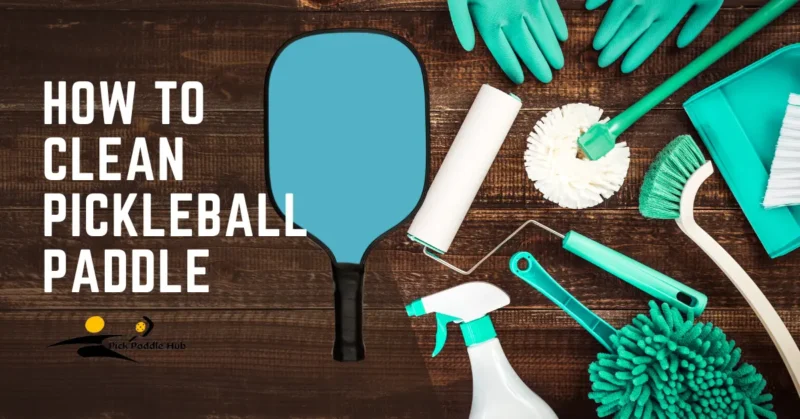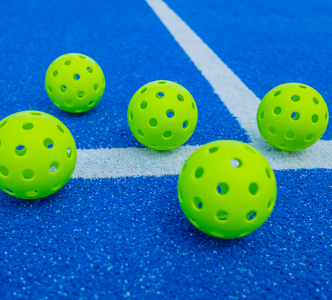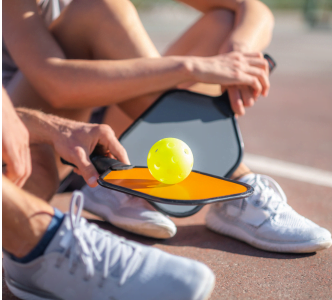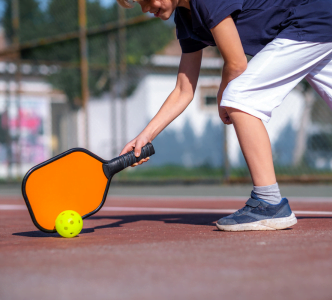If you’re just getting started, you’ve probably realized how essential your paddle is to the game. But did you know that keeping it clean is just as crucial? Cleaning your pickleball paddle isn’t just about aesthetics, it directly impacts your performance on the court and the lifespan of your gear.
Dirt, sweat, and grime can affect the paddle’s grip and the smoothness of its surface, potentially altering the accuracy and power of your shots. In this guide, we’ll dive into practical advice on how to clean a pickleball paddle and maintain it in tip-top shape, ensuring that every game is your best game. Let’s get started on this simple yet vital aspect of pickleball care!
Recommended Cleaning Materials
| Material | Use Case |
|---|---|
| Mild Soap | Gentle cleaning agent for removing dirt and grime. |
| Water (Lukewarm) | To mix with mild soap for cleaning. |
| Soft Cloth | For applying the soap solution and drying the paddle. |
| Toothbrush (Soft) | To gently scrub off stubborn dirt from the paddle’s surface. |
| Isopropyl Alcohol | For disinfecting the paddle handle without damaging the grip. |
What to Avoid to Prevent Damage
| Material | Reason to Avoid |
|---|---|
| Abrasive Cleaners | Can scratch or degrade the paddle’s surface. |
| Bleach | Can discolor and weaken the paddle material. |
| High Heat | Warping or damaging the paddle’s structure. |
| Excessive Water | Soaking can damage the core material of the paddle. |
| Harsh Chemicals | Can deteriorate the paddle’s surface and grip. |
How To Clean a Pickleball Paddle: Step-by-Step Guide
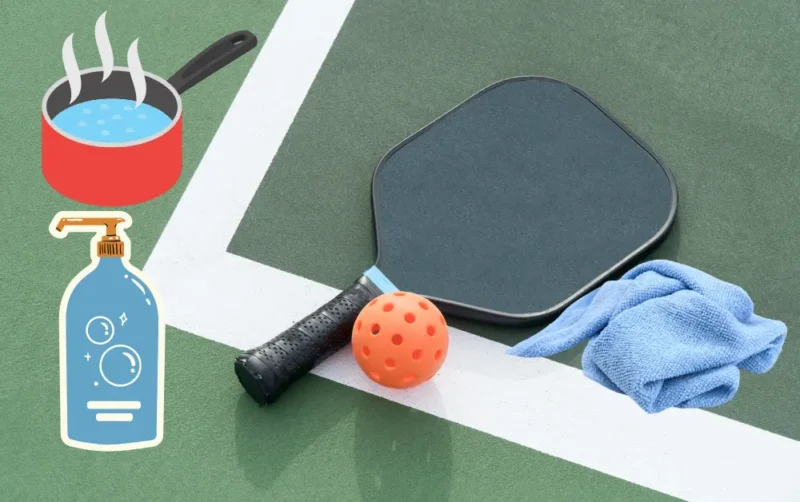
Maintaining your pickleball paddle with regular cleanings can significantly extend its life and enhance your gameplay. Here’s a detailed, easy-to-follow guide to keep your paddle looking and performing its best.
Pre-Cleaning Preparation
Before diving into the cleaning process, ensure you have all the necessary materials at hand (refer to the materials table provided earlier). Start by mixing a few drops of mild soap with lukewarm water in a small bowl. This solution will be effective yet gentle on your paddle’s surface. Have your soft cloth or sponge and toothbrush ready for the different cleaning stages. It’s also wise to clean your paddle in a well-lit area so you can easily spot dirt and grime.
Cleaning the Surface and Handle
- Surface Cleaning: Dip the soft cloth into the soapy water, wring it out so it’s damp, not wet, and gently wipe the surface of the paddle. Clean both the front and back faces, moving in circular motions to lift and remove dirt effectively. Be thorough but gentle to avoid scratching or damaging the paddle’s finish.
- Handle Cleaning: The handle may harbour sweat and oils from your hands, making it a breeding ground for bacteria. Use a separate cloth dampened with a bit of isopropyl alcohol to wipe down the handle. This will disinfect the area without harming the grip. If your paddle has a sweatband or grip tape, consider replacing it periodically for hygiene and comfort.
- Drying: After cleaning, use a dry, soft cloth to gently pat down the paddle, removing any excess moisture. Ensure the paddle is completely dry before storing it away. This prevents moisture accumulation, which could damage the paddle over time.
Addressing Stubborn Dirt and Grime
Sometimes, you’ll encounter dirt that’s a bit more stubborn. For these instances:
- Soft Toothbrush: Use a soft-bristled toothbrush dipped in your soapy water solution to gently scrub the tough spots. This can be particularly effective around the edges and handle where dirt tends to accumulate. Be careful not to scrub too hard to avoid scratching the surface.
- Spot Cleaning: For isolated spots of dirt or grime, apply a small amount of isopropyl alcohol on a cloth and gently dab the area. This can help in removing the grime without spreading it further.
Is The Cleaning Process and Materials the Same for Every Type of Paddle?
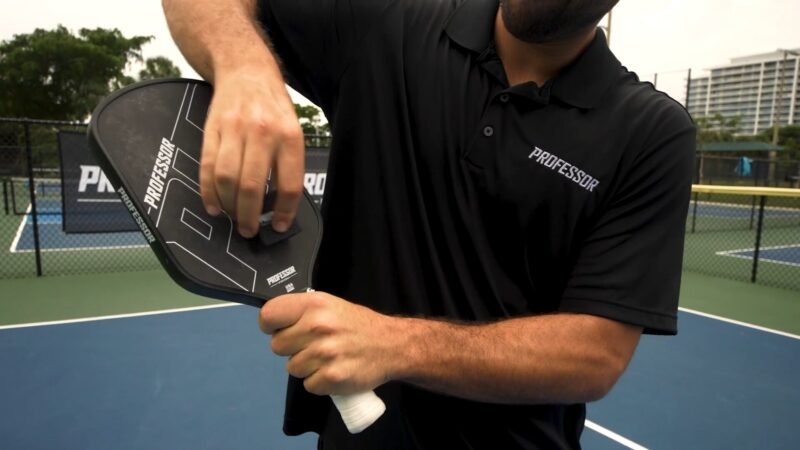
There are differences between pickleball paddles, So The basic principles of cleaning pickleball paddles—using gentle, non-abrasive materials and avoiding harsh chemicals—are applicable across different types of paddles. However, the specific materials used in the construction of the paddle can influence the best practices for cleaning.
For example, paddles made from composite materials, graphite, or carbon fiber generally require similar care: a mild soap solution, a soft cloth, and avoiding submersion in water. These materials are sensitive to harsh chemicals and abrasive cleaning tools, which can damage their surfaces or affect their structural integrity.
On the other hand, paddles with textured surfaces or those made from wood may have different considerations. Textured paddles might need a softer brush to get into the crevices without damaging the surface, while wooden paddles require extra care to avoid water absorption and warping. Always drying the paddle thoroughly after cleaning is a universal step, but it’s especially critical for wood.
It’s a good idea to consult the manufacturer’s care instructions for your specific paddle, as they may provide recommendations tailored to the materials and construction of your equipment. This ensures that you’re not only keeping your paddle clean but also preserving its quality and lifespan.
Cleaning raw carbon fiber pickleball paddles
Cleaning a raw carbon fiber pickleball paddle requires a gentle touch to maintain its integrity while ensuring it remains clean for optimal performance. Start by preparing a solution of mild soap and lukewarm water.
Using a soft cloth, lightly dampened in the soapy water, gently wipe the surface of the paddle in a circular motion to remove dirt, grime, and sweat. It’s important to avoid using abrasive materials or harsh chemicals, as these can damage the carbon fiber surface.
For tougher spots, a soft-bristled toothbrush can be used sparingly with the same soapy water solution, applying minimal pressure to avoid scratching the paddle.
After cleaning, rinse the cloth in clean water, wring it out well, and wipe the paddle down to remove any soap residue. Then, use a dry, soft towel to pat the paddle dry, ensuring no moisture is left on the surface.
Avoid exposing the paddle to direct heat or sunlight to dry, instead, allow it to air dry in a well-ventilated, shaded area. Regular cleaning of your raw carbon fiber paddle in this manner will not only keep it looking great but also maintain its performance and longevity on the court.
Drying and Storing Your Pickleball Paddle
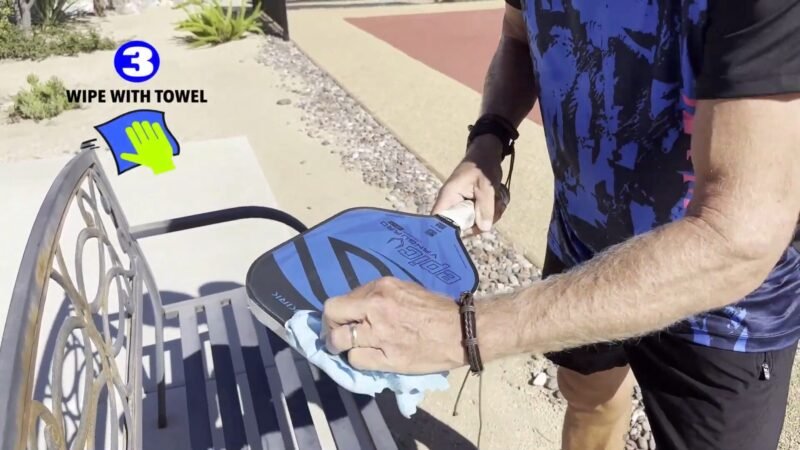
After cleaning your pickleball paddle, drying and storing it properly is crucial to prevent damage and ensure it’s ready for your next game. Here’s how to do it right.
Proper Drying Techniques
Once you’ve cleaned your paddle, avoid the temptation to leave it to air dry. Instead, use a soft, dry cloth to gently pat down the paddle’s surface and handle, absorbing any excess moisture. This step is vital to prevent water from seeping into the paddle, which could weaken its structure over time. Ensure the paddle is completely dry before moving on to storage.
Tips for Safe Storage
To store your paddle safely and maintain its condition, follow the guidelines presented in the table below:
| Tip | Reason |
|---|---|
| Avoid Direct Sunlight | Don’t Stack Heavy Items on the Top |
| Store in a Cool, Dry Place | Prolonged exposure can fade the paddle’s colours and degrade the material. |
| Use a Paddle Cover | Protects against dust, scratches, and accidental damage while not in use. |
| Don’t Stack Heavy Items on Top | Prevents warping or cracking by ensuring the paddle maintains its shape and integrity. |
| Hang or Lay Flat | Prevents bending or warping; hanging is ideal for space efficiency, laying flat for shape preservation. |
When Should You Clean Your Pickleball Paddle?
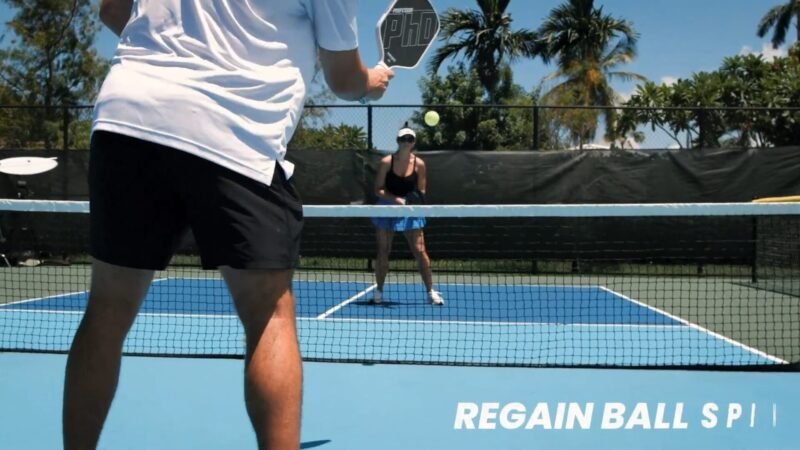
Knowing when to clean your pickleball paddle is key to its upkeep and your performance. Ideally, you should give it a basic wipe-down after every game to remove sweat, dust, and dirt that can accumulate during play. This prevents the build-up of grime and ensures the paddle maintains its grip and surface quality.
If you play frequently, a more thorough cleaning is recommended at least once a month. This involves not just wiping the surface, but also addressing the handle and any stubborn spots that may have formed. Regular players will notice dirt accumulates faster, affecting the paddle’s feel and responsiveness.
Additionally, if your paddle has been exposed to extreme conditions, such as playing on a sandy beach or in a dusty environment, it’s wise to clean it immediately after use. Such conditions can accelerate the accumulation of particles that can scratch or degrade the paddle’s surface. By keeping an eye on these factors, you can ensure your paddle remains in top condition for every game.
Why Cleaning Your Pickleball Paddle is Important
Keeping your pickleball paddle clean is essential for maintaining its effectiveness and longevity. Over time, dirt, grime, and sweat can accumulate on the surface and handle, potentially affecting the paddle’s grip and the smoothness of its face. This buildup can lead to a decrease in the paddle’s overall performance, making regular cleaning not just a matter of hygiene but a crucial part of your equipment maintenance routine.
Furthermore, regular cleaning helps prevent odour and bacteria buildup, especially on the handle, which is in constant contact with your hands. A clean paddle ensures a healthier playing environment by minimizing the risk of skin irritations or infections that can occur from handling a dirty paddle. It’s an easy yet significant way to protect both your health and your investment in your pickleball gear.
Lastly, ensuring peak performance on the court is directly linked to the condition of your paddle. A clean paddle provides a consistent playing surface, allowing for better control and accuracy of your shots. This attention to detail can make a noticeable difference in your game, demonstrating that a well-maintained paddle is an integral part of achieving your best performance.
When to Replace Your Pickleball Grip: Signs
- The most obvious sign is visible wear. If the grip starts to fray, peel, or has noticeable smooth spots, it’s time for it to be replaced.
- A good grip should feel slightly tacky to the touch. If your grip feels slippery even when dry, this indicates it has lost its effectiveness.
- If you find your hand cramping more than usual or you’re having difficulty maintaining a firm hold during play, your grip might be to blame.
- When the grip no longer absorbs sweat effectively, leading to increased slippage during play, it’s a clear sign you need a new one.
Choosing the Right Grip for Your Paddle
Selecting the right grip is crucial for maximizing performance and comfort. Here are factors to consider:
- Thicker grips can provide more cushioning, which is beneficial for players with larger hands or those seeking extra comfort. Thinner grips offer a better feel and control.
- Grips come in various materials, including synthetic, rubber, and foam. Choose one that feels comfortable and provides the right amount of tackiness for your play style.
- If you have sweaty hands, look for a grip with high absorbency to maintain control and reduce slippage.
- Consider the durability of the grip material, especially if you play frequently, to ensure it lasts and provides consistent performance.
Caring For Your Pickleball Paddle
In addition to regular cleaning your pickleball paddle, take these extra steps to lengthen the life of your paddle:
- Avoid Extreme Temps: Heat and cold can damage the paddle materials.
- Prevent Exposure to Liquids: Don’t submerge your paddle; store it in a dry place.
- Handle with Care: Don’t slam or drop your paddle; store it safely.
- Inspect for Damage: Look for dents, cracks, dead spots, etc.
- Replace Worn Parts: Re-tape edge guards or install protective skins when needed.
With some basic care and maintenance, a high-quality pickleball paddle should provide 1-5 years of play.
Avoiding Common Mistakes That Lead to Pickleball Paddle Damage
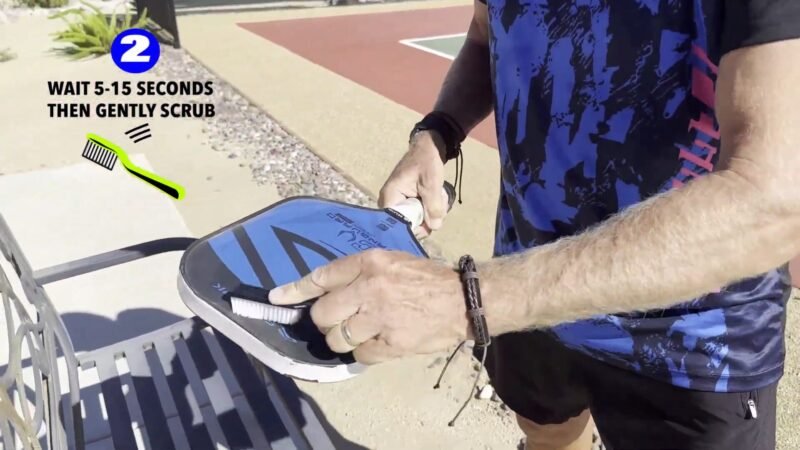
Ensuring your pickleball paddle remains in top condition involves more than just regular cleaning and maintenance; it’s also about avoiding certain habits that can lead to premature wear and damage. Here’s how to sidestep common pitfalls:
Improper Use
One of the quickest ways to damage your paddle is by using it for purposes other than playing pickleball. Avoid hitting objects other than the ball, such as the ground or net posts, as this can cause cracks or chips in the paddle surface. Always use the paddle as intended to maintain its integrity.
Neglecting Regular Maintenance
Regular cleaning and inspection can catch minor issues before they become major problems. Failing to clean your paddle can allow dirt and grime to accumulate, leading to a loss of surface texture and grip quality. Additionally, neglecting to inspect your paddle for damage can mean missing out on early signs of wear that, if addressed promptly, could extend the life of your paddle.
Poor Storage Practices
How and where you store your paddle can significantly impact its lifespan. Avoid leaving your paddle in extreme temperatures, such as in a hot car or direct sunlight for extended periods, as this can warp the paddle or degrade the materials. Similarly, storing your paddle in a wet location can introduce moisture into the core materials, leading to potential mold growth or structural weakness. Always store your paddle in a cool, dry place when not in use.
When to Replace Your Pickleball Paddle?
While regular cleaning can maximize the lifespan of your favourite paddle, normal wear and tear will take a toll over time. Here are some signs it may be time to shop for a replacement:
- Visible cracks, dents, delamination or dead spots on the paddle face
- Faded, peeled or bubbling graphics
- A grip that feels permanently slippery
- Holes, rips or missing sections of the edge guard
- A warped overall shape that feels unbalanced
You might also enjoy
- Is there a Fake pickleball paddle
- How to make a pickleball paddle
- Guide to left-handed pickleball paddles
Final Thoughts
Taking good care of your pickleball paddle ensures you always have the right tools to play your best on the courts. Just a few minutes of regular cleaning and proper storage go a long way towards preserving the condition and performance of your favourite paddle.
With the proper maintenance, a high-quality pickleball paddle should provide a dedicated player with years of ideal play. Along with replacing worn parts occasionally, keeping the surface and grip clean are the keys to maximizing your paddle’s lifespan.
So grab a microfiber cloth and some warm water after your next trip to the pickleball courts. A quick cleaning will remove any buildup and keep your trusty paddle in its best possible playing condition!
FAQs
How often should I clean my pickleball paddle?
It’s recommended to clean your paddle every time you play, especially wiping down the grip after use to remove dirt and sweat. Do a thorough cleaning of the surface and edge guard whenever you notice visible buildup.
What’s the best way to clean paddle graphics?
Use a damp microfiber cloth and gently wipe the graphics to avoid erasing them. Don’t use abrasive materials. Fading over time is normal due to ball impact.
Can I use household cleaners on my paddle?
Avoid household cleaners like window or all-purpose sprays, as they can leave a sticky, oily residue. Use only water, mild soap and grip cleaner designed for paddles.
How do I clean a carbon fiber paddle?
Use a dedicated carbon fiber cleaning block after play to restore the paddle’s gritty texture. Wipe gently to remove debris caught on the surface.
Should I clean my wooden paddle differently?
Use the same method of wiping with a barely damp microfiber cloth. Avoid submerging in water. Check for cracks in the wood over time.
How can I make my grip tacky again?
Regularly use a grip cleaning solution designed for paddles. This helps remove dirt buildup and restore stickiness as the grip ages.

